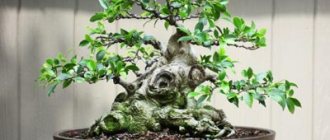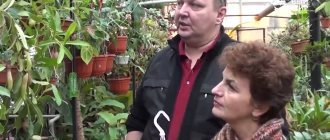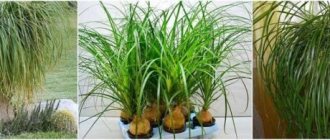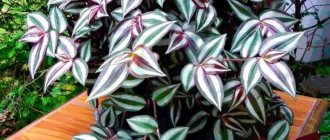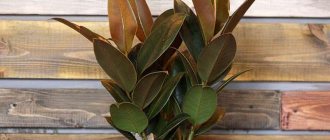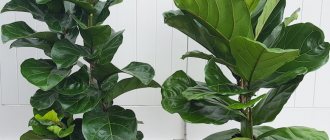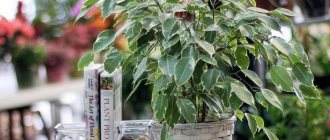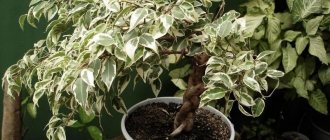Characteristics of the variety
Abidjan is one of the most common varieties of rubber-bearing ficus (elastica). The plant, originally from Asia, despite the fear of drafts and love of the sun, has successfully adapted to our country and successfully grows in houses and apartments.
Description:
- height about 1.5 m;
- the stem is thick, fleshy, green;
- leaves are dense, leathery with a glossy surface, oval, pointed at the tips;
- sheet plate size - 27x17 cm;
- in adult specimens over 8 years of age, slight branching is observed - shoots grow at an angle of 40-45°, densely covered with leaves;
- The root system is branched with numerous small roots.
Benefits and harms
Rubber-bearing ficus not only purifies indoor air, but also has a beneficial effect on the energy of the home. Ficus helps to find peace, get rid of anxiety and anger, and promotes proper resolution of problems.
Ficus juice has a healing effect; it is taken for uterine tumors and mastopathy.
The milky sap may cause dermatitis or an allergic reaction. Ficus is also not suitable for growing for people suffering from asthma.
How to choose in the store and price
For the last few years, Ficus elastica Abidjan has not been considered exotic, so you can buy it at any flower shop.
Price 1000-1200 rubles (depending on the height of the specimen).
When purchasing, you should pay attention to the appearance:
- the stem and leaves should be whole, dense and fresh, of a uniform dark green color;
- it is important that the buds and leaves do not have yellowness, black or reddish spots, which indicate the presence of diseases or pests;
- the substrate should be slightly moistened, without acidification and mold.
If the crown sheds its leaves when shaking, it is better to discard it. Through the drainage holes you can determine the condition of the roots: if they turn black or become moldy, this means that the plant is sick with something.
The best time to buy is spring or summer, because in the cold season the flower takes longer to acclimatize.
Transfer rules
Typically, this procedure begins after a three-week quarantine. Keeping a flower in another room helps determine its condition and health.
Light, slightly acidic soil is suitable for replanting. You can also prepare such a mixture yourself by mixing turf, leaf soil and sand in a ratio of 2:2:1.
Use a tall container - at least 15 cm, with a circumference of 10 cm. You can take a ceramic or plastic pot with drainage holes at the bottom.
Technology:
- A handful of expanded clay or pebbles are placed at the bottom. Then half the volume is sprinkled with fertile soil.
- The plant is shed generously with water, after a couple of hours it is removed and, together with the earthen lump, transferred to a new pot. If necessary, add soil around the edges, trample down, and water with warm, settled water.
Not only purchased flowers need to be replanted, but also homemade ones, as they grow very quickly.
The frequency of the procedure is every three years, while taking a container 2-3 cm larger in diameter than the previous one.
An unscheduled transplant is carried out if the root system is rotten or the plant is sick/attacked by pests.
To do this: water the ficus, remove it from the pot, and lower it into a container of water to wash off the remaining soil. The roots are dried, all diseased areas are cut out to healthy tissue, then sprinkled with charcoal. After a couple of hours, they are planted in a new pot with a sterile substrate.
Varieties and decorative forms of rubber ficus
Ordinary dark green ficus elastica are almost crowded out of shelves and catalogs by a variety of decorative Dutch cultivars and forms:
- “Decora” is an olive variety with a bronze tint of shoots and young leaves;
- "Belize" - pink and white marbled variety;
- “Melany” is a small-leaved, densely bushy, capricious variety with a dark color and purple young leaves;
- "Schriveriana" - compact yellow-leaved spotted form;
- "Robusta" (Robusta) is a dark-leaved variety with a rich, almost black color and wrinkled leaves;
- "Burgundy" - a spectacular purple-leaved variety;
- "Tricolor" (Tricolor) - a variety with colored petioles and a play of pink and cream spots with several shades of a basic green tone on the leaves;
- "Tineke" - a capricious variety with anise and white spots;
- "Doescheri" - a narrow-leaved variety with an uneven creamy border and interesting pinkish undertones of marble patterns;
- “Black Prince” is a variety with an unusual grayish tint of dark green color;
- "Variegata" is a classic white-edged, unevenly variegated ficus;
- "Abidjan" is an unusual variety with red young leaves.
Ficus elastica, or rubber (Ficus elastica), variety “Belize”. © GRUUN
Ficus elastica, or rubber-bearing (Ficus elastica), variety "Burgundy" (Burgundy). © pistilsnursery
Ficus elastica, or rubber (Ficus elastica), variety “Abidjan”. © gardenersdreamuk
Growing conditions
Protect the plant from direct sunlight
This light-loving plant can be placed on an eastern or western windowsill with access to diffused daylight.
If your flower is located on a south window, it needs to be shaded every day, otherwise the leaves will quickly burn and turn yellow.
When kept on the north side, the ficus grows slowly and the leaves turn pale.
Temperature:
- In spring and summer - 20-24°C.
- In autumn and winter - 16-17°C.
In the warm season, the flower is taken to the western balcony or loggia. You can also place it outdoors under trees or tall bushes, which will protect it from burning in the sun.
Ficus prefers high air humidity (80-85%), so it should be sprayed with water at room temperature every day. In winter and autumn, the frequency is reduced to 2 times a week.
Additionally, the plant can be placed on a tray with wet pebbles or expanded clay, as well as an open container with water.
In winter, keep away from heating appliances. Often ventilate the room, after moving the ficus to another room.
Folk signs and superstitions
Some people who believe in folk omens are convinced that the presence of a ficus tree in the house drives away potential suitors from the girl living in it. In addition, the flower can negatively affect the character of men living nearby. However, in Thailand, this plant is considered sacred and capable of bringing happiness and good luck.
Did you know? There is a belief: if a girl asks her friends who are already raising a child for a ficus sprout, and then carefully looks after it, she can soon become pregnant.
In China, they believe that it harmoniously combines in the interior with furniture and other decorative items, and also has a pleasant aura. Growing ficus will not take much of your time and will not create any inconvenience if you have a spacious home and like to grow flowers in pots. Such a long-lived plant will surprise guests and delight the family.
Rules of care
This variety of rubber-bearing ficus has good resistance and hardiness, so it is not considered demanding in care.
Watering
The plant loves moisture - it is watered regularly, preventing the earthen clod from drying out. For humidification, use melt, settled or rain water. In spring and summer, during the active growth phase, moisturize frequently - every 3-4 days, in the cold season - once a week.
Abidjan does not tolerate excess moisture well; with frequent overwatering, its root system begins to rot. You can save the plant if you remove it from the pot, wash off the soil, cut off the damaged areas, dry it, powder it with charcoal and replant it in a new container with fresh soil mixture.
It’s easy to determine the need for moisture - just dig the soil to a depth of 3 cm, if it’s dry, then it’s time to water.
In combination with watering, the leaves are irrigated with a spray bottle, which helps maintain decorativeness, improve leaf growth and protect against parasite invasion.
A day after each moistening, surface loosening is carried out so that the soil does not form a crust.
Feeding
Balanced and regular nutrition provides the plant with good immunity and rapid growth.
From spring to early autumn, ficus is fertilized twice a month with complex compounds. Many people alternate feeding: the first time with organic matter, the second time with mineral fertilizers.
For better absorption of nutritional components, abundant watering is carried out after the procedure. Water also prevents burning of the root system.
Additionally, you can fertilize the leaves - spray once a month with Zircon or Epin.
Crown trimming and shaping
The top of the crown needs to be pinched
With good nutrition and regular watering, the flower quickly reaches large sizes - up to 50 cm in a year. To prevent excessive stretching, it is periodically pinched.
This is usually done in the spring - the central stem is shortened by 20 cm in length, the side shoots by 10 cm. Using this technique, you will be able to form a compact and beautiful crown.
It is necessary to use a sharp and sterile instrument to eliminate the risk of severe injury and infection of the plant.
Transfer
It is advisable to replant as the bush grows. The more the ficus crown has developed, the more crowded its root system becomes in a cramped pot. And even if the plant was initially planted in a large container, it is worth changing the soil in the pot every 2-3 years. This will significantly stimulate the plant to rapid development and growth.
The plant is replanted using the transshipment method. You should not destroy the main lump, as this can damage the main roots. In order for some of the old earth to collapse, you can lightly pour water on it from all sides. Then the plant must be placed in the prepared pot and, having covered it with earth from different sides, lightly compacted.
Important! In no case should you forget about drainage! Without a layer of drainage, the lower roots of the plant will quickly begin to rot!
Reproduction
There are two ways to propagate a flower at home, each of them has pros and cons.
Cuttings
The cutting is carried out in the spring, the top is taken from the central stem, cut off at a height of 12-15 cm. Then it is lowered into a vessel with water and waits for the roots to develop. This usually takes 3-4 weeks. To prevent the appearance of mold, the water is changed every three days.
The second rooting option is planting in the ground and covering with a transparent film. Some gardeners prefer rooting in peat tablets.
By layering
This method of reproduction is as follows:
- a 1/3 cut is made on the main stem;
- a little sand is placed into the incision, which will prevent it from accreting;
- the prepared area is wrapped with moss or plastic wrap;
- As soon as the roots break through the winding, the apical stem is cut off and planted in a separate flowerpot.
Peculiarities
The homeland of the Abidjan ficus is West Africa, the city of Abidjan, which translated from the local language means “cut foliage”.
This is a beautiful, luxurious tree of the rubber genus with dense glossy dark green leaves. It is characterized by oval leaves with a pointed end and a smooth surface. Initially they unfold red. Gradually, only the burgundy vein remains.
The length of the leaves is 20-30 cm, width is 15-20 cm. The stem of the tree is green, the bottom is grayish, tree-like.
In indoor conditions, ficus grows up to one and a half meters, without growing much in width.
The plant is a long-livers - it can live up to 50 years. It will not bloom, but will decorate the interior. Propagated by cuttings.
Diseases and pests
Usually, infection with diseases or parasites occurs due to violation of the rules of planting, care and maintenance.
- Powdery mildew. This is a fungal disease that appears as a whitish coating on stems, shoots and foliage. Over time it becomes watery. Treatment is carried out using fungicides - Fundazol or Ridomil gold. Treat the crown and soil twice with an interval of 7 days.
- Shield. Small reddish or brown plaques are a sure sign of the appearance of this pest. It attaches itself to the stem and leaves and sucks out the juices from them. Treatment is carried out as follows: remove insects with a cotton pad soaked in a soap solution. Then they are sprayed with insecticides - Actellik or Aktara.
- Spider mite. It envelops internodes and leaves on the underside with a fine web, feeds on their juice and leads to the death of the flower. The parasite can be destroyed if treated with Aktara or Aktellik. For prevention, you should increase the humidity and lower the temperature in the room.
- Centipedes. When they appear, the root system gradually withers, followed by the entire crown. Therefore, such a plant must be removed, washed from soil residues, sprayed with a fungicide on the roots, dried and replanted in a new container with fresh substrate.
Temperature
Caring for ficus Abidjan at home involves observing the temperature regime. The plant feels comfortable at temperatures from +18 to +24 degrees in the warm season, and in winter it needs to be provided with a temperature of 16-18 degrees.
If the room is hot (above +25 °C), then the ficus needs additional moisture in the form of spraying. In the cold season, the pot is additionally insulated with warm fabric. If the pot is on the floor, and the tree itself does not have time to grow, then it must be placed on an elevated surface, since hypothermia greatly harms the roots.
Problems during cultivation
Due to ignorance or inexperience, many gardeners make various mistakes in care and maintenance, which cause the death of the plant:
- Yellowing of leaves can be caused by a lack or excess of water. Therefore, before each watering it is necessary to check the condition of the soil.
- Mass leaf fall is provoked by two factors - the flower goes through an acclimatization stage or suffers from a lack of nutrients.
- Drying and darkening of the leaves at the tips is a sign of lack of moisture or high temperature.
- The leaves turn yellow when kept in a dark place. To fix this problem, it needs to be moved to a room with diffused daylight.
Formation
Abidjan differs from other varieties in its growth rate - it quickly develops upward, almost without forming lateral branches. In good light, the main stem will grow rapidly, giving an increase of about half a meter per year. Because of this, the plant is limited in growth during formation. It helps to form a beautiful tree.
The first pruning is carried out at the height required, measuring approximately 30 cm from the top. Side shoots are pinched at a distance of 10 cm from the top. With this method, new branches begin to form on the upper bud.
Usually, during formation, the growth of only one point is activated. Therefore, in the photo there are often several bushes planted in one container. This growing method allows you to get a lush shrub and make it decorative.
Tree formation is carried out in summer or spring.
Ficus elastica Abidjan home care
An attractive appearance, purifying the air in the house - all this is provided by the Abidjan ficus. This unpretentious plant was very popular with our grandmothers. The plant got its name from the locality in Africa where it comes from.
Among all rubber species, it was the ficus Abidjan that for a long time remained one of the most common. Ficus is believed to have magical properties.
Different peoples of the world associate various signs and beliefs with it, and the first mention of the plant is found in the Bible.
Ficus Abidjan home care
Ficus Abidjan is one of the most common varieties of rubber-bearing ficus elastica. It belongs to the Mulberry family.
This is an evergreen tree that reaches 30-40 m in height, and at home it grows up to 1.5 m.
Did you know? In their natural habitat, ficus trees reach the size of large trees and can grow up to 50 meters in height, and their leaves can reach 1 m in length. Its leaves are oval-shaped and pointed, with a glossy surface.
Their length can be 20-30 cm and width - 10-20 cm.
Their color depends on the age of the plant. So, a young ficus has pink-brown leaves, while an old one has dark green leaves.
Its small fruits are oval in shape and reach 1 cm in diameter. Some experts claim that ficuses of this species are not prone to flowering at home. In nature, the flowers of the plant are small in size and have a spherical shape, reaching a diameter of 1 cm. The phenomenon when a flower bears fruit can occur if the plant is already more than 10 years old.
Ficus Abidjan Ficus Abidjan is one of the most common indoor plants, which has long won the love of gardeners. It looks great both in an apartment and in an office, decorating the room and giving it a little exoticism.
Ficus Abidjan is an evergreen plant with a wide and massive stem and can reach a height of up to 1.5 meters.
It has dense, shiny and smooth oval-shaped leaves with pointed ends, which grow up to 25 cm in length and 18 cm in width.
The plant in question is excellent for keeping at home. To do this, you just need to monitor the lighting, temperature, air humidity and watering.
In India, ficus is believed to have healing properties, so its leaves and roots are boiled in oil and then used to heal wounds.
After you have purchased a ficus Abidjan, do not rush to replant it, because the plant needs to get used to the new conditions.
This can be done in a few weeks. The described flower is unpretentious in care. The main thing is to find a suitable place for it: bright, located away from direct sunlight.
It should not be placed in a dark place as this may slow down its growth.
It would be completely inappropriate to place the ficus in a draft, because this will cause its leaves to become covered with dark spots or even fall off.
Since the plant prefers high humidity, it is necessary not only to observe the watering conditions, but also to wipe its leaves with a damp sponge. In addition, once a month you should organize a warm shower for him.
Before this procedure, the soil must be covered with polyethylene. For successful care at home, you should follow some rules.
Description and photo of the variety
So, it is necessary to follow the watering and fertilizing regime. In addition, it is important to familiarize yourself with the nuances of crown formation and plant transplantation. Ficus prefers moderate watering, although high humidity can be detrimental to the soil.
Since the plant's root system is capable of quickly absorbing moisture, this can lead to rotting. Watering should be done with warm and pre-settled water. The best way to moisturize is to spray the leaves, but do not forget to wipe them with a dry sponge afterwards.
In summer, water the ficus 1 - 2 times a week, in winter - 1 time every 2 weeks. To determine whether the plant needs watering, insert a fork into the soil to a depth of 3-4 cm.
Peculiarities
If you see that the cutlery is dry, then the ficus needs watering. If the ground is still wet, then this procedure can be postponed.
This type of ficus prefers fertile and high-quality soil containing all the necessary substances and minerals. The structure of the soil should be soft and loose.
For a five-year-old plant, a mixture containing turf soil, peat and sand is suitable.
In addition, in the warm season it needs to be fed using dietary supplements. Since the tree grows 50 cm in 1 year, it is necessary to monitor its crown. To do this, the main stems should be connected at a height of 20 cm. Those that grow sideways must be removed.
A flower that can be grown in any room - ficus "Abidjan"
This will give the flower a beautiful shape and will not stress it. When the ficus grows, it will need to be replanted. This manipulation will have to be performed 1-2 times a year.
In this case, drainage must always be located at the bottom of the container. A young plant needs to be replanted every six months when the pot is filled with its roots. For this, as a rule, the period chosen is from the end of winter to the beginning of spring.
In this case, the pot must be chosen such that its dimensions exceed the dimensions of the previous container by 2-3 cm in diameter. The soil can be purchased at a specialty store and add a little charcoal to it.
Find out how and when to replant indoor plants. In order to transplant ficus Abidjan, you need to follow the following algorithm of actions: In order to grow ficus from cuttings, you need to follow these steps:
Since tap water is too hard in structure, that is why it is not suitable for watering plants. Like any other ficus, this one loves when you give it time.
The best way is to spray it daily with a spray bottle and then wipe it off. This way the plant is cared for, plus it’s a great way to prevent dust mites from destroying it. In warm periods, ficus can be watered several times a week, but in cold periods - once every 2 weeks.
Such standards will not harm the pet in any way, and it will always be healthy.
Luxurious glossy leaves, unpretentious care, fast growth - this is just the dream of any gardener. The foliage color is dark green, the center vein is light green above and dark burgundy below. The stem is vertical and green.
To check whether the plant needs watering, you need to take a fork and insert it into the ground, about 3 cm. If the ground is still wet, then you can’t water it; if the ground is dry, you can safely irrigate the flower with water.
As experts say, ficuses of this type almost never bloom at home. It is difficult to understand what they are missing, perhaps the sun, or perhaps the root system is too crowded, and because of this it cannot grow enough to bear fruit.
There are rare cases when a flower bears fruit; usually this phenomenon can be found when the flower is more than 10 years old. Ficus Abidjan photos confirm that the flowers of this plant are small: about one centimeter in diameter.
Caring for this plant will not be difficult. And even more so, the main thing is to follow all the rules and instructions when caring for the crown. At home, ficus grows quite quickly.
Ficus Abidjan - three conditions for successful cultivation
The growth of a young tree in 1 year can be over 50 cm. To avoid a meter-long palm tree at home occupying the entire space, it is necessary to connect the shoots so that the tree does not rapidly grow and stretch upward.
This type of ficus belongs to very quickly growing and developing plants, but still such upward impulses must be restrained, because the larger the flower, the larger the area it needs.
The main stem of the ficus should be connected at a height of approximately 20 cm, so as not to cause much damage to the tree and not bring the plant to a state of stress. Stems that will grow to the side also need to be trimmed.
In this way you can create a beautiful shape for the ficus. Ficus Abidjan in the photo allows you to see its beauty. This type of ficus loves calm and non-aggressive soil. The soil must be fertile and of high quality.
The newest and youngest seedlings will grow very actively and quickly, so they need nutritious soil so that they can take from it all the vitamins and microelements necessary for the system. Also, the structure of the soil should be soft and quite loose.
Ficus Abidjan is an excellent solution for those who want to have a lush, large and aesthetic indoor plant, while requiring a minimum of care. This tropical tree is one of the most unpretentious indoor plants, but there is still a certain set of rules for its maintenance.
This is required so that the root system of the tree can germinate well and strengthen in a new place. For a ficus that is more than five years old, an earthen mixture consisting of turf, peat and clean sand is perfect. During warm periods, the flower must be fed with universal dietary supplements.
Ficus Abidjan: home care
Preferably once a month. An adult tree needs to be replanted 1 or 2 times a year. You should always add drainage to the bottom of the pot so that the ficus can quickly get used to and adapt. Young growth must be replanted every six months. Ficus reproduces in two ways:
Ficus is an unpretentious flower that will be a wonderful addition to any collection of house plants and interior decoration.
Rules for caring for ficus Abidjan
It does not require much care and always pleases with beautiful and large leaves of rich green color. Ficus Abidjan. Kira Stoletova.
Source: https://xn—-8sb8amcue.xn--p1ai/fikus-abidzhan-uhod-v-domashnih.php
Ficus Abidjan care at home photo
Ficus Abidjan is an ornamental plant valued for its large, beautiful leaves. When comfortable conditions are created, the bush intensively grows green mass and looks very impressive.
Caring for the plant at home is not difficult; even a novice gardener can handle it. The main thing is to choose a place for the ficus in the house where the plant has enough light and warmth.
Ficus Abidjan
Abidjan (elastica Abidjan) is one of the types of rubber-bearing ficuses that grow successfully at home. A distinctive characteristic of the plant is its beautiful leaves with a smooth, glossy dark green surface, with burgundy veins on the underside. The shape of the leaves is oval with a sharp tip, 20-25 cm long, 15-17 cm wide.
When suitable conditions are created, the bush reaches a height of 1.5 meters, and in a greenhouse with proper lighting it grows without restrictions. Ficus Abidjan is a long-liver and can reach the age of 50 years. Under artificial conditions it practically does not bloom, does not form seeds, and is propagated by cuttings.
Growing conditions
Successful growth of a heat-loving, evergreen plant is possible if the lighting conditions, ambient temperature and regular soil moisture are observed. These parameters must be taken into account when purchasing.
Lighting
Light intensity plays a key role in the life of a plant:
Therefore, it is best to place the ficus pot closer to the window , and use artificial lighting in winter. Windows on the western or eastern side of the house are best suited for the plant.
Humidity
Ficus Abidjan, the care and maintenance of which practically comes down to watering only, is responsive to both a lack and an excess of moisture.
- Watering should be carried out regularly ; complete drying out of the earth clod is unacceptable, but excessive waterlogging is also not advisable.
- At reduced temperatures and lighting in winter, watering is reduced to once a week.
- During hot summer periods, ficus is watered every 3-4 days to avoid drying out of the soil.
Ficus loves “water procedures”. The leaves are sprayed with a spray bottle and cleaned of dust using a napkin or soft sponge. The procedures are especially relevant during hot summer periods and in winter, when the air is very dry in rooms with central heating.
How to form a ficus
The plant has a fast growth rate and does not naturally form side shoots. Ficus Abidjan photos clearly demonstrate this feature. An erect stem in good light gives growth of up to 45-50 cm per year.
To limit the height and form a bush, it is systematically pruned.
- The main stem of a young plant is cut at a height of 25-30 cm, and the shoots are pinched at a level of 10 cm. In this case, a new shoot is formed from the upper bud.
- You can also simply bend the top of the ficus and thus stimulate an additional bud to awaken.
- After pruning, only one growth point can form on the shoot. Therefore, several plants are planted in a pot or rooted cuttings are planted. In this way it is easier to form a bush with a rich, lush crown.
Pruning is carried out before periods of intensive growth, which occur in spring and early autumn.

